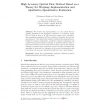Free Online Productivity Tools
i2Speak
i2Symbol
i2OCR
iTex2Img
iWeb2Print
iWeb2Shot
i2Type
iPdf2Split
iPdf2Merge
i2Bopomofo
i2Arabic
i2Style
i2Image
i2PDF
iLatex2Rtf
Sci2ools
128
Voted
ICIAR
2007
Springer
2007
Springer
High Accuracy Optical Flow Method Based on a Theory for Warping: Implementation and Qualitative/Quantitative Evaluation
Abstract. We describe the implementation of a 2D optical flow algorithm published in the European Conference on Computer Vision (ECCV 2004) by Brox et al. [1] (best paper award) and a qualitative and quantitative evaluation of it for a number of synthetic and real image sequences. Their optical flow method combines three assumptions: a brightness constancy assumption, a gradient constancy assumption and a spatio-temporal smoothness constraint. A numerical scheme based on fixed point iterations is used. Their method uses a coarse-to-fine warping strategy to measure larger optical flow vectors. We have investigated the algorithm in detail and our evaluation of the method demonstrates that it produces very accurate optical flow fields from only 2 input images.
| Added | 08 Jun 2010 |
| Updated | 08 Jun 2010 |
| Type | Conference |
| Year | 2007 |
| Where | ICIAR |
| Authors | Mohammad Faisal, John Barron |
Comments (0)

